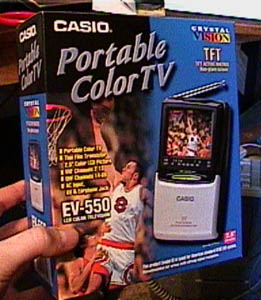![]()
I found some article off the Internet
(where else?) that explained how to get composite video off your Atari. They called it a 'bare-bones' approach. Well, I tended to agree, because it only partially worked!
Before I explain how I got it working CORRECTLY, a little history. There are 3 chips inside the Atari 2600.
The 6507 Processor. This blazing chip could reach speeds of 1.19 MHZ. (I'm not sure what it could do
over clocked, maybe run Half Life, who knows?). The 6507 chip is quite similar to the 6502. The 6502, as you might recall, was used in everything from the Nintendo 8-bit, to the Apple II,
to the Atari 400/800 line, to the Atomic Bomb, and even, in an altered form, to the Turbo Graphix-16. Yes, that chip got around, alright.
The RIOT Chip. This chip did stuff like look at joystick ports, switches, I/O crap, and stuff of that nature. If you refer back to the last page, I mentioned wiring the SELECT and RESET button directly to it. Now you know why! Also, the RIOT contained the Atari 2600's RAM. A whole 128 BYTES!
(In perspective. Let's say you have a computer with 64 megs RAM. That's 524,288 times more
RAM than the Atari had.)
The Stella Chip. This is the chip that did all the graphics of the Atari 2600. It was called Stella,
also the code-name of the system. "Stella" was the name of an Atari employee's
bicycle. Hey, it was the 70's, alright?
Ok! So, according to this web site I found, if a person hooked a lead to pins 2, 5, 7
& 8 of the Stella chip, they got LUMA output. And, by hooking a lead up to a certain resistor, they got CHROMA. And by hooking the LUMA and CHROMA together, you get COMPOSITE. And with
COMPOSITE, you could hook that to a VIDEO IN on a VCR or TV and get a nice, clean signal! My intention was to use a portable TV unit as the screen for the Atari, and the portable TV's usually have VIDEO IN, so, that's what I wanted to use.
I hooked up the video as described in the article I found. It worked, but the colors weren't quite right. They looked OK in simple games, such as
2600 Pac-Man (but who wants to play that?), but more complex (ahem BETTER) games like Pitfall had
incorrect colors and REALLY complex games like Pitfall II just looked like
utter CRAP. Hm...
I scoured the Internet some more, and found another method of getting video off the Atari. This method involved a complex circuit, involving resistors and things. But it still hooked up to the same pins on the Stella chip.
"Hm!" I thought
"There must be a common ground here someplace. But where?"
I decided to use BOTH methods. I put a potentiometer on each wire. Anyone that has
made it this far into my boring tirade probably knows what one is, but, if you don't,
I'll tell you. A potentiometer is basically a volume control. A variable resistor. Using the
potentiometers, I was able to adjust how much signal came off each wire.
Well, it worked. I adjusted each and got a correct signal. The vines, dirt, trees and bricks
of Pitfall all looked right. I drilled small holes in the circuit board of the Atari and
attached the potentiometers right to it! If I ever needed to adjust the signal, I could.

The TV I used. It's a Casio EV-550. The screen is a 2.5 inch TFT (thin
filament transistor) active matrix, which means moving images don't
'smear' like they did on old laptops or the original Gameboy. The EV-550
can tune in TV stations, but I didn't think that was a feature my Atari
needed. All I needed was the video input so I could get the signals from
the Atari. As for the case, I tossed that as well and only kept the
screen, speaker and the circuit board. It was a far, far better thing it
did than it had ever done.
Sound was easy. It involved hooking one lead up to
the junction of a resistor and a capacitor, then attaching the other lead to ground.
Now I had audio and video. Next came THE CASE...